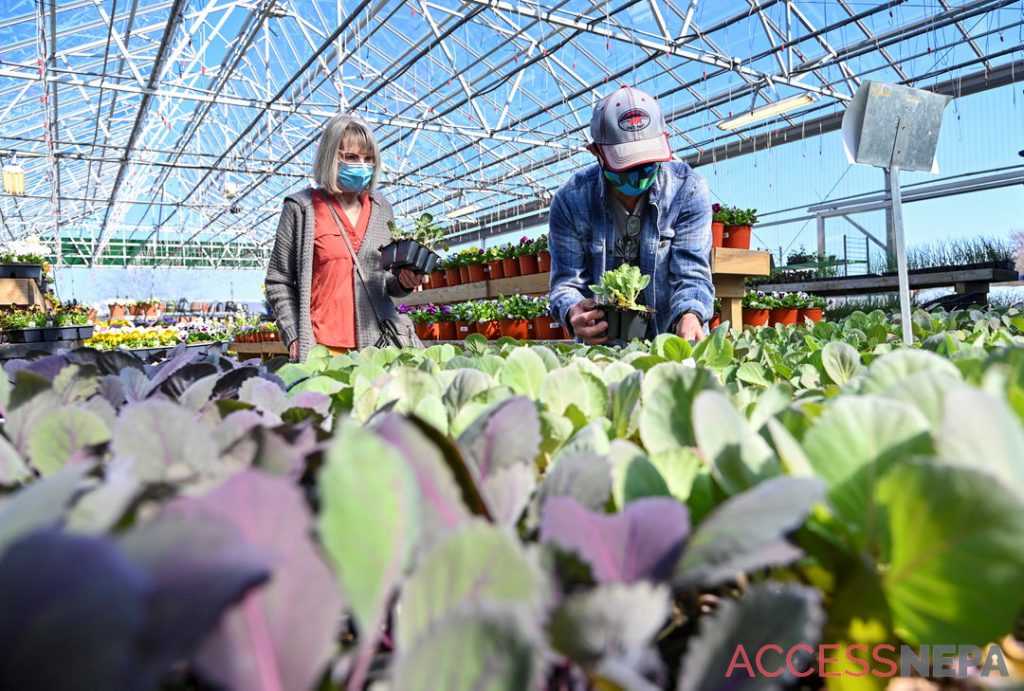Lots of people turned to gardening to get them through the pandemic last year, and that trend looks to continue this spring, too.
According to a survey by Minneapolis-based firm Axiom Marketing, 48% said COVID-19 increased their interest and involvement in gardening, and 86% of homeowners plan to garden as much as or even more than they did last year. Among the most popular gardening activities are growing flowers (nearly 73%), followed by growing shrubs and vegetables, according to the survey.
“The only thing we’re anticipating is it’s going to be busy just like last year,” said Allison Longo, owner of Jerry’s for All Seasons in Dunmore.
With people not spending as much money on traveling because of the pandemic, Longo expects they’ll use those funds instead to landscape their homes this year. And while some people saw gardening as an activity to try while stuck at home during the pandemic in 2020, Longo said people also tried canning vegetables, which made planting produce popular. With some people still worried about going out in public during the pandemic, she said, she expects vegetable gardening “to go through the roof.”
“Last year, we couldn’t get tomato plants, and we sell a lot of them,” Longo said. “We never run out. We’ve been here for 17, 18 years, and we’ve never run out of tomato plants except last year.”
Tomatoes are a popular product at Jerry’s in part because the store sells upwards of 50 to 60 varieties of them, she added, but they’re also really easy to grow.
“You just have to water them and make sure you put them in the sun,” she said.
Most vegetables grow easily, though, especially peppers and cucumbers, and so do beans, Longo added. She also sells hundreds of types of herbs as well as unique finds, like popcorn.
Gardeners can start seedlings indoors now, and Longo also has some cold-weather crops available. Generally in this area, May 15 is considered the date after which gardeners can start planting outside, Longo said, although that’s not guaranteed. If you plant outdoors and temperatures dip below 32 F, cover your plants to protect them from the cold weather, she added.

SUBMITTED PHOTO
Tomatoes are an easy vegetable to grow at home.

JASON FARMER / STAFF PHOTOGRAPHER Rose Marie and Charlie Gluck of West Scranton pick out vegetable plants
Support pollinators
Pollinators such as bees, butterflies, moths and even bats play a vital role in nature, carrying pollen among flowers, which results in fertilization and leads to the creation of more plants, many of which provide the world with vital nutrition. These creatures are responsible for supporting not only fruits such as blueberries, peaches and apples but also squash, coffee and chocolate, according to the Penn State Extension.
Pollinators have declined in recent years for several reasons, including pathogens, poor nutrition, habitat loss, climate, weather and pesticides, according to the Extension. But you can step up to support them at home.
If you’d like to attract pollinators to your garden, the Extension suggests picking native plants and nectar- and pollen-rich flowers that come in a variety of colors, shapes and sizes. Native plants “will flourish without the addition of fertilizers and pesticides,” and having a diverse selection of flowers helps “because each pollinator has its own techniques for sourcing nectar and pollen,” according to the Extension.
The Extension also suggests that gardeners avoid planting modern hybrid plants, which can actually make it tougher for pollinators to find nectar; plant flowers that will bloom at different times from summer to fall so pollinators always have a supply; buy at least three of one kind of a flower and plant them near each other, as drifts of color make it easier for pollinators to find plants; and avoid using landscape fabric and mulch. After the season ends, the Extension suggests, leave your perennial garden cleanup for the following early April, as some pollinators overwinter in this natural leaf litter.

DAVID MCKEOWN / STAFF PHOTOGRAPHER
Spotted lanternflies hang from a tree of heaven in their nymph stage in Schuylkill Haven.
Spot the lanternflies
One pest local gardeners will want to keep an eye out for this year is the spotted lanternfly, an invasive species that has expanded its presence throughout Pennsylvania over the last few years. The insects are identifiable by their tan and red wings with black spots.
The Pennsylvania Department of Agriculture recently added Lackawanna, Pike and Wayne counties to the commonwealth’s spotted lanternfly quarantine zone, which also includes Luzerne and Monroe counties. The department also pointed out the municipalities with known spotted lanternfly infestations: Archbald, Carbondale, Dunmore, Jermyn, Jessup, Moosic, Scranton and Taylor plus Clifton, Covington, Fell, Jefferson and Thornhurst townships in Lackawanna County; Delaware, Dingman, Greene, Lehman, Milford, Porter and Shohola townships in Pike County; and Berlin, Lehigh, Palmyra and Sterling townships in Wayne County.
Penn State Extension has set up a spotted lanternfly resource page at extension.psu.edu/spotted-lanternfly, which can help people identify the insects at their various stages and provide tips for dealing with the pests. The state agriculture department also encourages residents of areas with infestations to report sightings to it.

Caitlin Heaney West is the content editor for Access NEPA and oversees the Early Access blog in addition to working as a copy editor and staff writer for The Times-Tribune. An award-winning journalist, she is a summa cum laude graduate of Shippensburg University and also earned a master’s degree from Marywood University. Caitlin joined the Times-Shamrock family in 2009 and lives in Scranton. Contact: cwest@timesshamrock.com; 570-348-9100 x5107; or @cheaneywest




